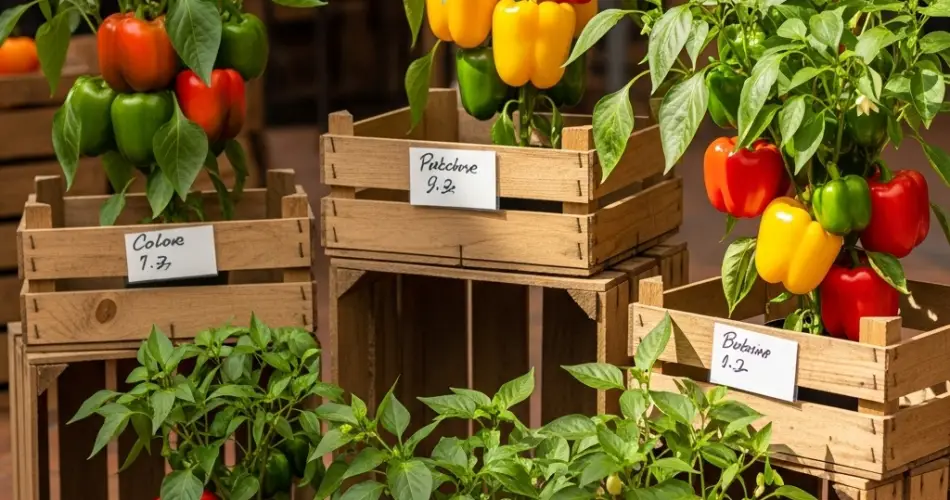Growing chili peppers and bell peppers in your backyard doesn’t require a large garden. In fact, you can enjoy a colorful, productive pepper harvest using nothing more than a few sturdy crates. This method is ideal for those with limited space, offering flexibility, style, and the satisfaction of fresh produce right outside your door.
Peppers are heat-loving plants that thrive in warm, sunny conditions. Whether you prefer the sweet crunch of bell peppers or the fiery kick of chilies, crate gardening lets you grow them successfully without the need for a traditional plot.
Why Use Crates for Peppers?
Planting peppers in crates offers several distinct advantages:
-
Space-Saving – Perfect for balconies, patios, and small backyards.
-
Better Soil Control – You can create the perfect growing medium for healthy root development.
-
Portability – Move crates to sunnier spots or protect them during storms.
-
Pest Reduction – Elevating plants helps deter certain ground pests.
-
Aesthetic Appeal – Wooden crates add a rustic touch to any garden setting.
Choosing the Right Crates
Select untreated wooden crates at least 12 inches deep to give roots enough room to grow. Line the inside with burlap or landscape fabric to keep soil in place while allowing excess water to drain. Small gaps at the bottom will prevent waterlogging, which peppers dislike.
If you plan to grow multiple plants in one crate, choose a wider model to allow adequate spacing.
Best Pepper Varieties for Crate Growing
Bell Peppers (Sweet):
-
California Wonder
-
Golden Bell
-
Purple Beauty
Chili Peppers (Hot to Medium Heat):
-
Jalapeño
-
Cayenne
-
Thai Chili
-
Poblano
Compact varieties are generally better for crate gardening, but with proper support, larger plants can thrive as well.
What You’ll Need
-
Wooden crates (12–16 inches deep)
-
High-quality potting mix with compost
-
Pepper seedlings or seeds
-
Mulch (straw, shredded leaves, or coco husk)
-
Sunny location (6–8 hours of sunlight daily)
-
Small stakes or cages for support
Planting Peppers in Crates
-
Prepare the Crate
Place the crate where it will get plenty of direct sunlight. Fill it with a well-draining potting mix enriched with compost. Peppers do best in slightly acidic to neutral soil (pH 6.0–7.0). -
Planting Seedlings
If using seedlings, plant them 12–16 inches apart. This spacing ensures good airflow, which helps prevent disease. -
Planting Seeds
Sow seeds about ¼ inch deep. Keep the soil consistently moist until germination, which usually takes 1–2 weeks.
Caring for Crate-Grown Peppers
Peppers need regular care to produce well:
-
Watering – Keep soil evenly moist but avoid overwatering. During hot weather, daily watering may be necessary.
-
Feeding – Apply a balanced vegetable fertilizer every 2–3 weeks or use compost tea to keep plants nourished.
-
Support – As plants grow, provide stakes or cages to prevent branches from bending or breaking under the weight of the fruit.
Mulching for Better Results
A layer of mulch around the plants helps retain moisture, regulate soil temperature, and suppress weeds. Mulching also reduces water evaporation, which is especially helpful in crate gardening where soil can dry out faster.
Pest and Disease Control
Crate gardening naturally reduces some pest problems, but you should still keep an eye out for:
-
Aphids – Spray with insecticidal soap or hose off with a strong stream of water.
-
Spider Mites – Increase humidity around plants and use neem oil if necessary.
-
Blossom End Rot – Maintain consistent soil moisture and ensure adequate calcium in the soil.
Harvesting Your Peppers
Peppers can be harvested at different stages depending on flavor preference:
-
Bell Peppers – Pick green for a milder taste or allow them to ripen fully for sweeter flavor and vibrant colors.
-
Chilies – Pick when green for less heat or wait for them to turn red for maximum spiciness.
Use scissors or pruning shears to cut peppers from the plant to avoid damaging stems.
Extending the Growing Season
If cooler weather arrives early, you can extend your harvest by moving crates to a protected sunny area or inside a greenhouse. Peppers will continue producing as long as they have warmth and sunlight.
Final Thoughts
Backyard crate gardening for chili and bell peppers is an efficient, attractive, and productive way to grow your own fresh produce. By choosing the right varieties, providing good soil and care, and managing pests, you can enjoy a steady supply of peppers from summer well into fall.
With crates, even the smallest space can become a flourishing pepper garden—bringing a pop of color, a burst of flavor, and a touch of rustic charm to your home.



